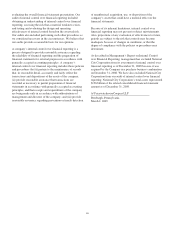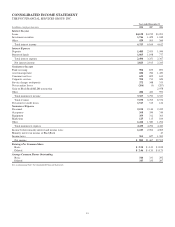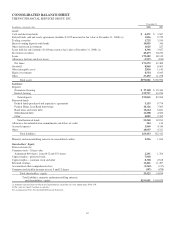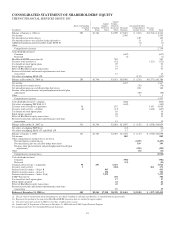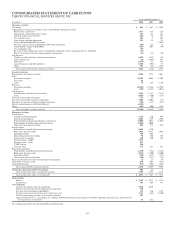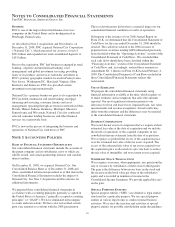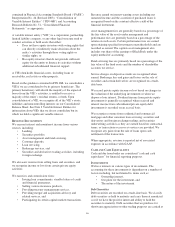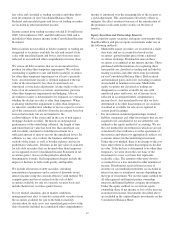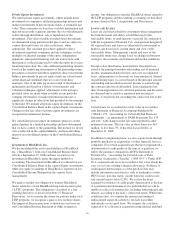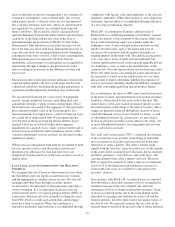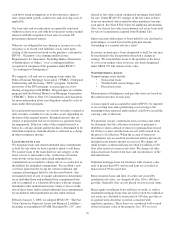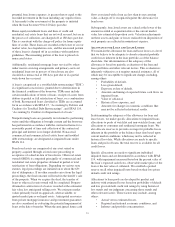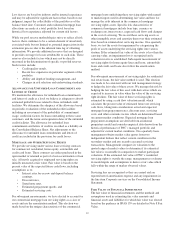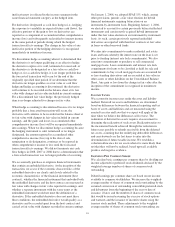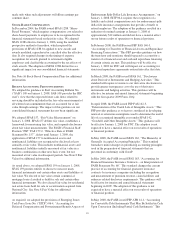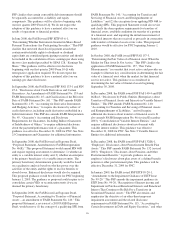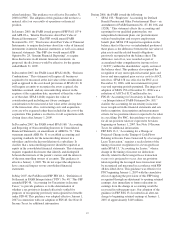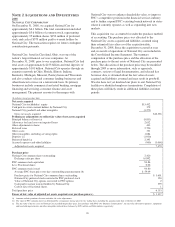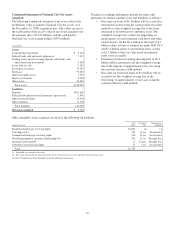PNC Bank 2008 Annual Report Download - page 93
Download and view the complete annual report
Please find page 93 of the 2008 PNC Bank annual report below. You can navigate through the pages in the report by either clicking on the pages listed below, or by using the keyword search tool below to find specific information within the annual report.party models that incorporate management’s best estimate of
current key assumptions, such as default rates, loss severity
and payment speeds. Collateral values are also incorporated
into cash flow estimates. Late fees, which are contractual but
not expected to be collected, are excluded from expected
future cash flows. The accretable yield is calculated based
upon the difference between the undiscounted expected future
cash flows of the loans and the fair value of the loan as
determined under the provisions of SFAS 157, Fair Value
Measurement. This amount is accreted into income over the
life of the loan on a level yield basis. Subsequent increases in
expected cash flows are recognized prospectively through an
adjustment of the loan’s or pool’s yield over its remaining life.
Subsequent decreases in expected cash flows that are
attributable, at least in part, to credit quality are recognized as
impairments through a change to the provision for credit
losses resulting in an increase in the allowance for loan and
lease losses.
The nonaccretable yield represents the difference between the
expected undiscounted cash flows of the loans and the total
contractual cash flows (including the principal and interest) at
acquisition and throughout the remaining lives of the loans.
We also provide financing for various types of equipment,
aircraft, energy and power systems, and rolling stock and
automobiles through a variety of lease arrangements. Direct
financing leases are carried at the aggregate of lease payments
plus estimated residual value of the leased property, less
unearned income. Leveraged leases, a form of financing lease,
are carried net of nonrecourse debt. We recognize income
over the term of the lease using the interest method. Lease
residual values are reviewed for other than temporary
impairment on a quarterly basis. Gains or losses on the sale of
leased assets are included in other noninterest income while
valuation adjustments on lease residuals are included in other
noninterest expense.
When loans are redesignated from held for investment to held
for sale, specific reserves and allocated pooled reserves
included in the allowance for loan and lease losses are
charged-off to reduce the basis of the loans to lower of cost or
market value.
L
OAN
S
ALES
,L
OAN
S
ECURITIZATIONS AND
R
ETAINED
I
NTERESTS
We recognize the sale of loans or other financial assets when
the transferred assets are legally isolated from our creditors
and the appropriate accounting criteria are met. We also sell
mortgage and other loans through secondary market
securitizations. Securitization of financial assets represents a
source of funding. In a securitization, financial assets are
transferred into trusts or to special-purpose entities (SPEs) in
transactions which are effective in legally isolating the assets
from PNC. Pools of credit card, automobile, and mortgage
loans have been securitized. Where the transferor is a
depository institution, legal isolation is accomplished through
compliance with specific rules and regulations of the relevant
regulatory authorities. Where the transferor is not a depository
institution, legal isolation is accomplished through utilization
of a two-step securitization structure.
SFAS 140 “Accounting for Transfers and Servicing of
Financial Assets and Extinguishments of Liabilities” requires
a true sale analysis of the treatment of the transfer under state
law as if the transferring equity was a debtor under the
bankruptcy code. A true sale legal analysis includes several
legally relevant factors, such as the nature and level of
recourse to the transferor, and the amount and nature of
retained interests in the loans sold. The analytical conclusion
as to a true sale is never absolute and unconditional, but
contains qualifications based on the inherent equitable powers
of a bankruptcy court, as well as the unsettled state of the
common law. Once the legal isolation test has been met under
SFAS 140, other factors concerning the nature and extent of
the transferor’s control over the transferred assets are taken
into account in order to determine whether derecognition of
assets is warranted, including whether the SPE has complied
with rules concerning qualifying special-purpose entities.
In a securitization, the trusts or SPE issues beneficial interests
in the form of senior and subordinated asset-backed securities
backed or collateralized by the assets sold to the trust. The
senior classes of the asset-backed securities typically receive
investment grade credit ratings at the time of issuance. These
ratings are generally achieved through the creation of lower-
rated subordinated classes of asset-backed securities, as well
as subordinated interests. In certain cases, we may retain a
portion or all of the securities issued, interest-only strips, one
or more subordinated tranches, servicing rights and, in some
cases, cash reserve accounts.
For credit card securitizations, PNC’s continued involvement
in the securitized assets includes maintaining an undivided,
pro rata interest in all credit card assets that are in the trust,
referred to as seller’s interest. The seller’s interest ranks
equally with the investors’ interests in the trust. As the amount
of the assets in the securitized pool fluctuates due to customer
payments, purchases, cash advances, and credit losses, the
carrying amount of the seller’s interest will vary. However,
PNC is required to maintain its seller’s interest at a minimum
level of 5% of the initial invested amount in each series to
ensure sufficient assets are available for allocation to the
investors’ interests.
In accordance with SFAS 140, securitized loans are removed
from the balance sheet and a net gain or loss is recognized in
noninterest income at the time of initial sale, and each
subsequent sale for revolving securitization structures. Gains
or losses recognized on the sale of the loans depend on the
allocation of carrying value between the loans sold and the
retained interests, based on their relative fair market values at
the date of sale. We generally estimate the fair value of the
retained interests based on the present value of future expected
89



